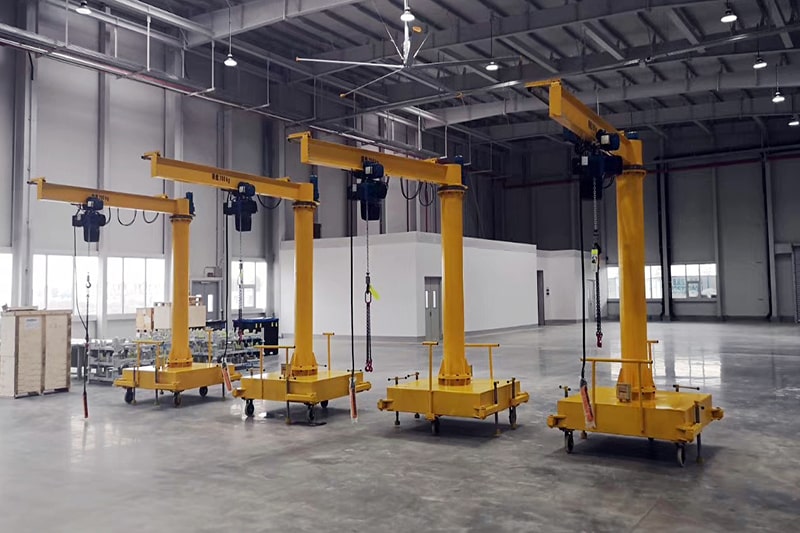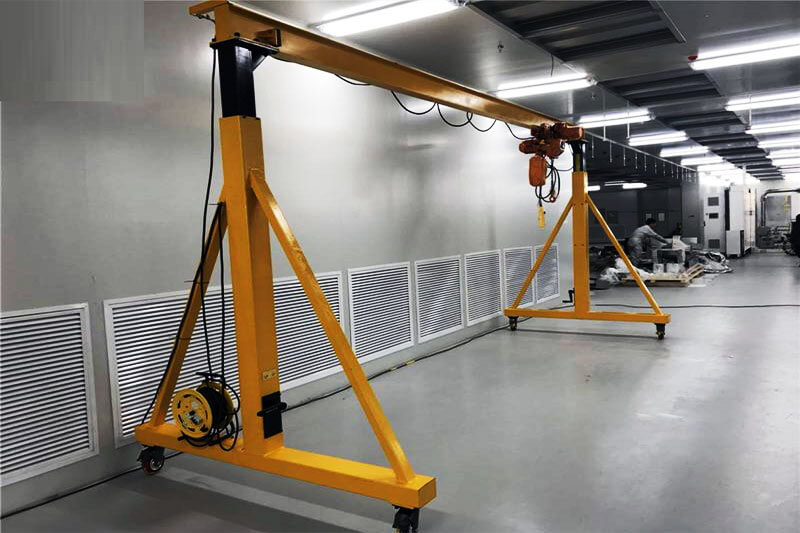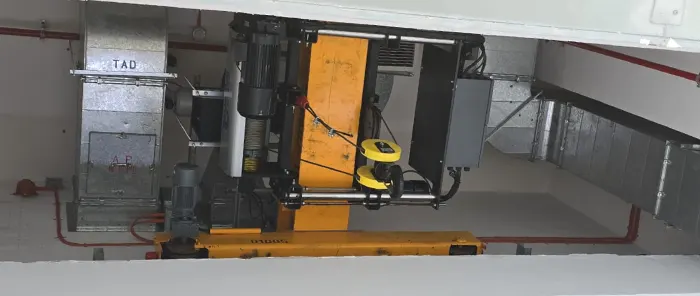Small Indoor Cranes for Sale, Types and Their Applications
Small indoor cranes for sale. Types of small indoor cranes for jib, gantry, and overhead cranes, tailored for efficient material handling applications.
Small indoor cranes are specialized lifting devices designed to move and position loads in confined spaces, typically within warehouses, workshops, and manufacturing facilities. These cranes are characterized by their compact size, allowing them to operate efficiently in areas where larger cranes would be impractical. Common types of small indoor cranes include jib cranes, gantry cranes, mini cranes, and overhead cranes. Each type has its own unique design features and capabilities, making them suitable for various applications, such as lifting heavy machinery, transporting materials, or assisting in assembly processes.
Small Indoor Cranes
The use of small indoor cranes plays a crucial role in enhancing operational efficiency and safety within indoor environments. By providing a reliable means of lifting and moving loads, these cranes reduce the physical strain on workers, minimizing the risk of injury. With their ability to quickly and accurately position materials, small indoor cranes help streamline workflows, increase productivity, and improve overall workplace safety.
Moreover, these cranes are designed with safety features that protect both operators and loads. Features such as limit switches, emergency stop buttons, and overload protection systems ensure that the cranes operate safely, reducing the likelihood of accidents. Their compact design also allows for better maneuverability, enabling operators to navigate tight spaces and perform tasks more effectively.
In summary, small indoor cranes are essential tools that not only facilitate the efficient handling of materials but also contribute to safer working conditions in various industrial settings. As industries continue to prioritize safety and productivity, the demand for small indoor cranes is likely to grow, making them indispensable in modern operations.
Types of Small Indoor Cranes
Jib Cranes

Design and Features
Jib cranes are versatile lifting devices characterized by a horizontal arm (the jib) that extends from a vertical support (the mast). They can be designed in several configurations, with the two most common types being pillar-mounted and wall-mounted jib cranes.
- Pillar-mounted Jib Cranes: These cranes have a freestanding vertical post that supports the ji They are typically used in applications where a fixed point is needed to lift and maneuver loads. The height of the jib can often be adjusted to accommodate various lifting needs.
- Wall-mounted Jib Cranes: As the name suggests, these cranes are attached to a wall or column. This design is ideal for areas with limited floor space, as it maximizes the available working areThe jib arm can swing in a circular motion, allowing for efficient movement of loads within a designated radius.
The structure of jib cranes often includes a rotating arm and a hoisting mechanism, which can be powered manually or through electric systems. The lightweight construction of many jib cranes allows for easier installation and relocation, making them suitable for dynamic work environments.
Applications
Jib cranes are widely used across various industries due to their adaptability and efficiency. Common applications include:
- Manufacturing: In production facilities, jib cranes assist in moving components and materials between workstations. Their ability to provide precise lifting and positioning makes them ideal for assembly tasks, especially when handling heavy machinery or parts.
- Assembly Lines: Jib cranes are essential in assembly line operations, where they help in the efficient handling of products as they move through various stages of production. Their flexibility allows operators to quickly lift and place items without disrupting the flow of work.
- Maintenance Tasks: These cranes are often employed in maintenance and repair tasks, particularly in environments such as warehouses and workshops. They facilitate the lifting of heavy tools and equipment, enabling technicians to perform repairs and maintenance safely and effectively.
Advantages
Jib cranes offer numerous advantages that make them a popular choice for indoor lifting applications:
- Flexibility: The ability to rotate and extend the jib arm allows operators to reach loads in tight spaces, making jib cranes ideal for various indoor environments. This flexibility enhances productivity by enabling quick load handling.
- Ease of Use: Jib cranes are generally user-friendly, with intuitive controls that make them accessible for operators of varying skill levels. Many models come with manual or powered hoists, providing options based on operational needs.
- Space-Saving Benefits: Jib cranes require minimal floor space compared to other crane types, such as gantry or overhead cranes. Their design allows for effective use of vertical space, making them ideal for crowded or constrained work areas. By maximizing operational efficiency within limited space, jib cranes contribute to a more organized and functional workspace.
Overall, jib cranes represent an excellent solution for various indoor lifting needs, combining practicality with ease of use to enhance workplace efficiency and safety.
Gantry Cranes

Design and Features
Gantry cranes are robust lifting devices that consist of a bridge spanning the distance between two vertical supports (legs). They can be classified into two primary types: fixed and adjustable gantry cranes.
- Fixed Gantry Cranes: These cranes have a rigid frame that is permanently anchored to a specific location. They are often used in applications where a consistent lifting capacity is required. Fixed gantry cranes typically feature a single or double girder design, allowing them to handle substantial loads over fixed distances.
- Adjustable Gantry Cranes: These cranes offer flexibility in height and width, making them suitable for varying operational requirements. Adjustable gantry cranes can be modified to accommodate different lifting needs, which is especially useful in environments where loads of varying sizes must be lifted. They often feature telescoping legs and adjustable beams, enabling operators to tailor the crane's dimensions to specific tasks.
Both types of gantry cranes are equipped with a hoist mechanism that can be powered manually or electrically, providing options for different lifting capabilities. The design of gantry cranes allows for smooth operation over a fixed path, enhancing efficiency in material handling.
Applications
Gantry cranes are utilized across several industries due to their strength and adaptability. Key applications include:
- Warehousing: In storage facilities, gantry cranes streamline the movement of heavy goods and pallets, facilitating quick loading and unloading processes. They are especially effective in optimizing vertical storage space, allowing for efficient retrieval of items stored at various heights.
- Shipping: Gantry cranes play a critical role in shipping yards, where they are used to load and unload shipping containers from trucks and vessels. Their ability to lift heavy and bulky loads makes them indispensable in port operations, ensuring the timely handling of cargo.
- Construction: In construction sites, gantry cranes assist in lifting and moving building materials, such as steel beams and concrete blocks. Their mobility and adjustable features enable them to adapt to different project needs, improving workflow and safety on-site.
Advantages
Gantry cranes offer a range of benefits that make them a preferred choice for various lifting applications:
- Mobility: Many gantry cranes are designed with wheels, allowing them to be easily moved around the workspace. This mobility enables operators to reposition the crane as needed, enhancing flexibility in handling different loads throughout a facility.
- Load Capacity Options: Gantry cranes can be built to handle a wide range of load capacities, from light-duty applications to heavy industrial lifting. This versatility makes them suitable for diverse tasks, accommodating everything from small components to substantial machinery.
- Versatility: The adjustable design of certain gantry cranes allows for customization based on specific lifting requirements. Whether used for manufacturing, shipping, or construction, gantry cranes can adapt to various tasks, making them an ideal solution for organizations that handle multiple types of materials.
Overall, gantry cranes are essential tools in many industrial settings, providing efficient lifting solutions that improve productivity, safety, and workflow in diverse applications. Their robust design and operational flexibility make them a valuable asset in any facility requiring material handling.
Overhead Cranes

Design and Features
Overhead cranes are powerful lifting devices that operate on an elevated track system, allowing them to move loads across a workspace with ease. They are primarily categorized into two designs: single girder and double girder.
- Single Girder Overhead Cranes: These cranes consist of a single beam that supports the hoist and is typically mounted on two end trucks that travel along the runway. This design is lighter and more cost-effective, making it suitable for lower lifting capacities and smaller spaces. Single girder cranes are ideal for applications where moderate lifting is required without the need for excessive strength.
- Double Girder Overhead Cranes: Featuring two parallel beams, double girder cranes offer greater stability and load capacity. This design allows for larger hoists and can accommodate heavier loads, making them suitable for heavy-duty applications. Double girder cranes provide increased headroom, allowing for more vertical lifting space, which can be crucial in manufacturing environments where height is essential.
Applications
Overhead cranes are widely utilized across various industries due to their efficiency and versatility. Common applications include:
- Manufacturing Plants: Overhead cranes are essential in manufacturing settings, where they facilitate the movement of heavy components, machinery, and materials. They are used for tasks such as assembling parts, lifting products for inspection, and transporting items along assembly lines.
- Warehouses: In storage facilities, overhead cranes streamline the process of loading and unloading goods, especially heavy pallets or equipment. Their ability to cover large areas allows for efficient management of inventory, reducing the time and effort required for material handling.
- Construction Sites: Overhead cranes are also utilized in construction projects to lift and position materials like steel beams and precast concrete. Their ability to navigate around large job sites makes them invaluable for keeping construction on schedule.
Advantages
Overhead cranes provide numerous benefits that enhance their effectiveness in various applications:
- Space Efficiency: By operating above the workspace, overhead cranes free up valuable floor space, allowing for more efficient use of the area below. This vertical lifting capability maximizes operational efficiency, making it easier to maneuver around other equipment or materials.
- Ability to Cover Large Areas: Overhead cranes can span wide distances, enabling them to lift and transport materials across extensive work areas. This capability is particularly beneficial in large facilities where moving heavy loads over long distances is necessary.
- Enhanced Safety: Overhead cranes are designed with safety features such as limit switches and emergency stop controls, reducing the risk of accidents. Their elevated operation minimizes the likelihood of collisions with other equipment or personnel, contributing to a safer working environment.
Overall, overhead cranes are critical tools in many industrial settings, providing reliable and efficient lifting solutions that improve productivity and safety. Their design flexibility and operational advantages make them an essential asset for manufacturers, warehouses, and construction sites alike.
Factors to Consider When Choosing Small Indoor Cranes
Load Capacity
Determining the appropriate crane capacity is crucial for ensuring that the equipment can handle the intended loads safely and effectively. Key considerations include:
- Weight of Loads: Evaluate the maximum weight of the items that will be lifted. Understanding the heaviest loads helps in selecting a crane with the right capacity to prevent overloading, which can lead to accidents or equipment failure.
- Frequency of Use: Consider how often the crane will be used and for what types of loads. Frequent lifting of heavy items may require a crane with a higher capacity to maintain safety and reliability over time.
- Dynamic Loads: Assess whether the loads will be static (stationary) or dynamic (in motion). Dynamic loads can exert additional forces on the crane, so it’s important to factor this into the load capacity when making a selection.
Space Requirements
Evaluating the available space is essential to ensure that the chosen crane fits well within the operational areKey aspects to consider include:
- Footprint: The crane’s base dimensions must fit within the workspace. Consider whether the crane will be used in a fixed location or if mobility is required. Mini and gantry cranes are ideal for smaller spaces due to their compact designs.
- Headroom: Assess the vertical space available, particularly if using overhead cranes. Ensure that there is sufficient headroom to accommodate the crane's height, including any additional clearance required for lifting loads.
- Obstructions: Identify any potential obstructions in the workspace, such as columns, beams, or machinery. Ensuring that the crane can operate without interference is vital for safe and efficient lifting.
Application Specificity
Matching the crane type to specific tasks and workflows is essential for optimizing operational efficiency. Key considerations include:
- Type of Work: Different crane types excel in different applications. For instance, jib cranes are ideal for lifting in tight spaces, while overhead cranes are better suited for moving heavy loads across larger areas. Understanding the specific tasks will guide the selection process.
- Workflow: Consider the flow of materials and how the crane will integrate into existing processes. Choose a crane that complements the workflow, whether it involves lifting, moving, or placing items, to enhance productivity.
- Environment: Evaluate the operational environment, including factors like temperature, humidity, and potential exposure to corrosive materials. This consideration may influence the choice of crane materials and design features.
Safety Features
Incorporating safety measures into crane design and operation is crucial for protecting both personnel and equipment. Important safety features to consider include:
- Limit Switches: These devices help prevent over-travel by automatically stopping the crane at predetermined points. Limit switches enhance safety by ensuring that loads are lifted and lowered within designated ranges.
- Emergency Stops: Including emergency stop buttons allows operators to quickly halt crane operation in case of an emergency, minimizing the risk of accidents.
- Load Indicators: Load monitoring systems provide real-time information on the weight being lifted, helping operators avoid overload situations. This feature is essential for maintaining safe lifting practices.
- Regular Maintenance: Establishing a maintenance schedule ensures that all safety features function correctly. Regular inspections can identify potential issues before they lead to equipment failures or safety incidents.
By carefully considering these factors, businesses can select the most suitable small indoor cranes that meet their operational needs while ensuring safety and efficiency in their material handling processes.
Conclusion
In summary, small indoor cranes play a vital role in enhancing efficiency and safety across various industrial applications. With several types available—such as jib cranes, gantry cranes, mini cranes, and overhead cranes—each offers unique advantages tailored to specific tasks. Jib cranes are particularly effective in tight spaces and assembly lines, while gantry cranes excel in mobility and heavy lifting capabilities. Mini cranes provide flexibility for urban construction and small workshops, and overhead cranes are essential for maximizing vertical space in manufacturing and warehousing settings. Understanding the distinct features and applications of each crane type allows businesses to make informed choices that improve operational workflows and safety.
As technology continues to evolve, the future of indoor cranes is poised for significant advancements. Automation and smart technologies are leading the way, with cranes becoming increasingly integrated with advanced control systems and artificial intelligence. These innovations will enhance operational efficiency, allowing for more precise lifting and movement of loads while reducing the risk of human error.
Moreover, the development of lightweight materials and improved designs will enable cranes to handle heavier loads while occupying less space, making them even more suitable for compact environments. Remote monitoring systems and predictive maintenance technologies will also contribute to safer operations by enabling timely interventions and minimizing downtime.
In conclusion, the ongoing advancements in indoor crane technology promise to further revolutionize material handling processes, making them safer, more efficient, and better suited to meet the demands of modern industries. As businesses continue to seek ways to optimize their operations, small indoor cranes will remain a critical component in achieving these goals.




